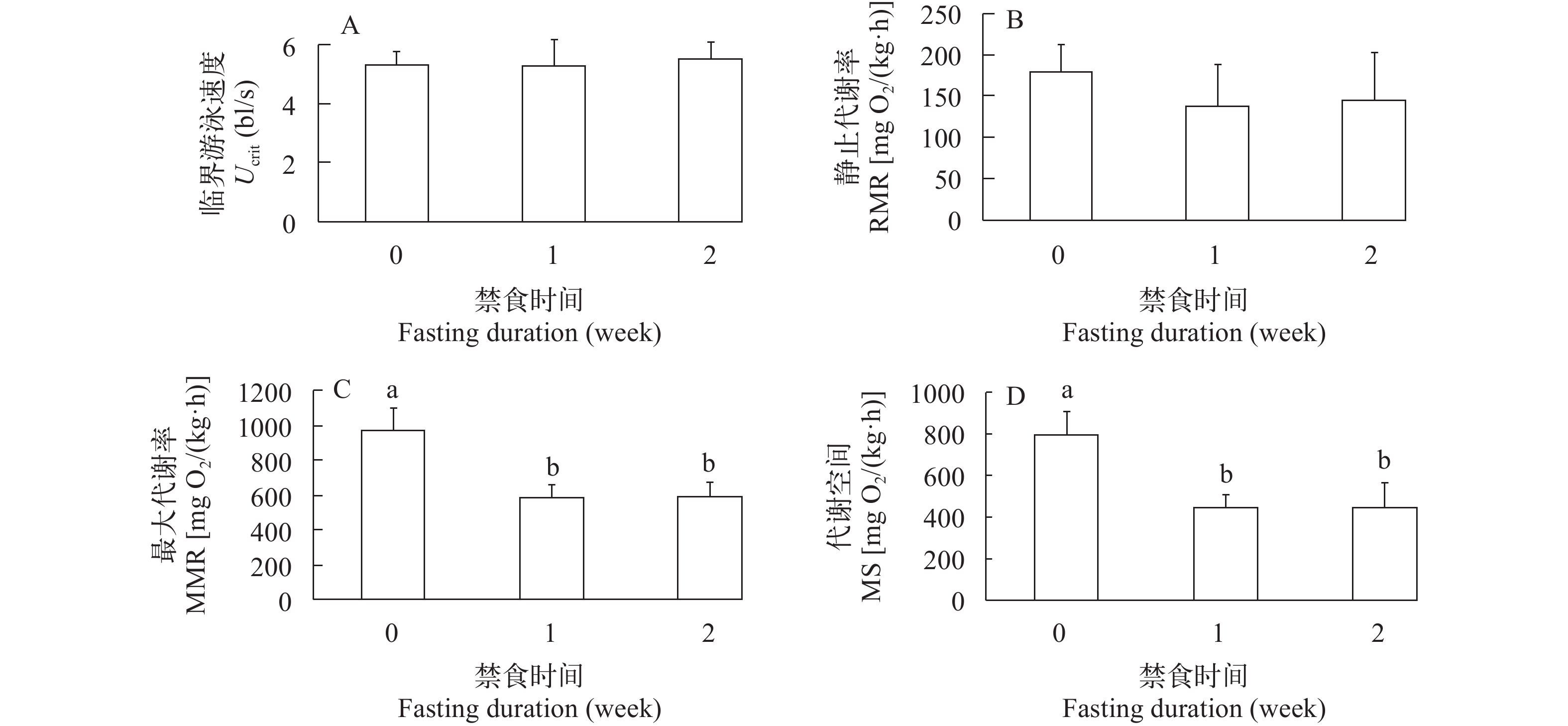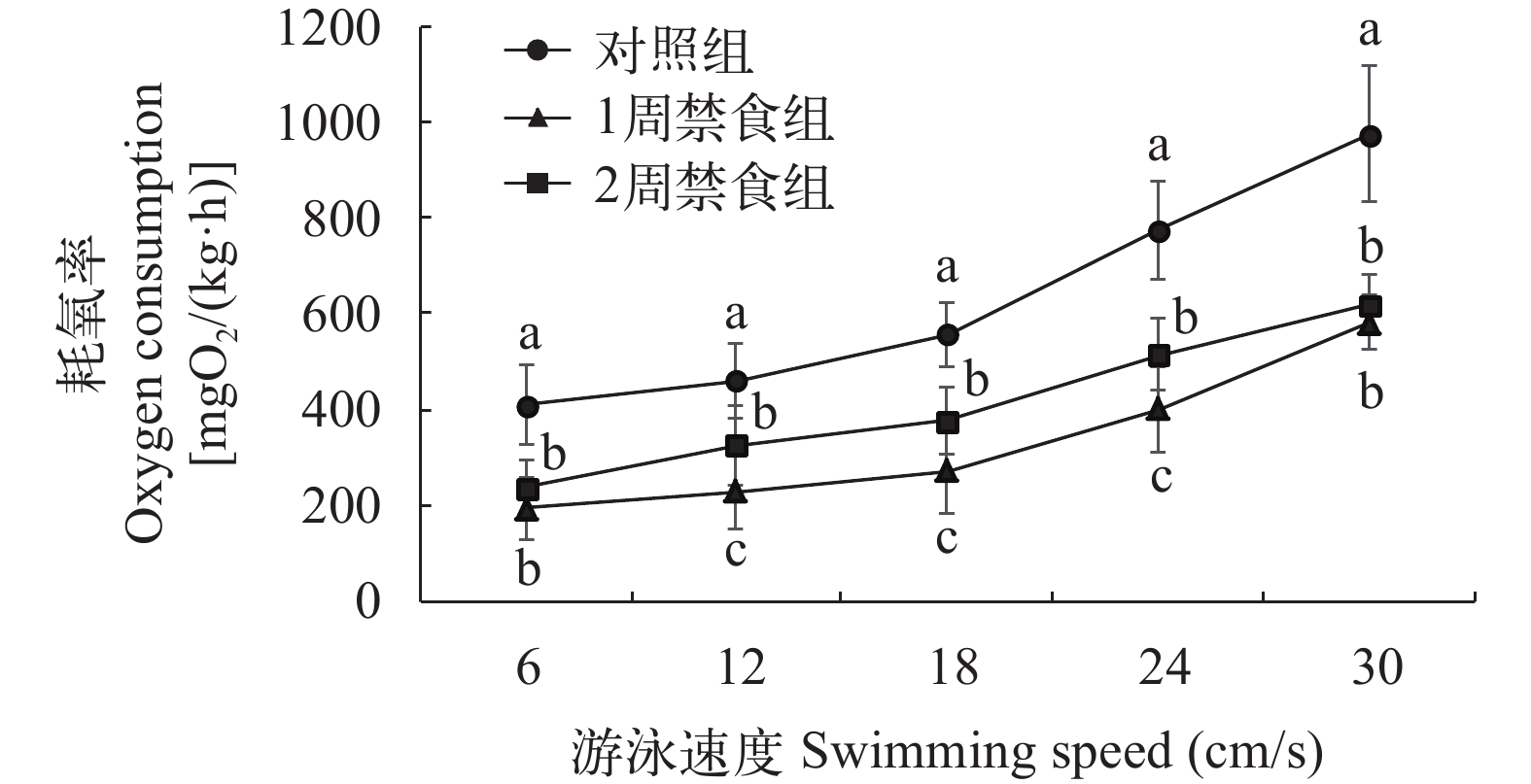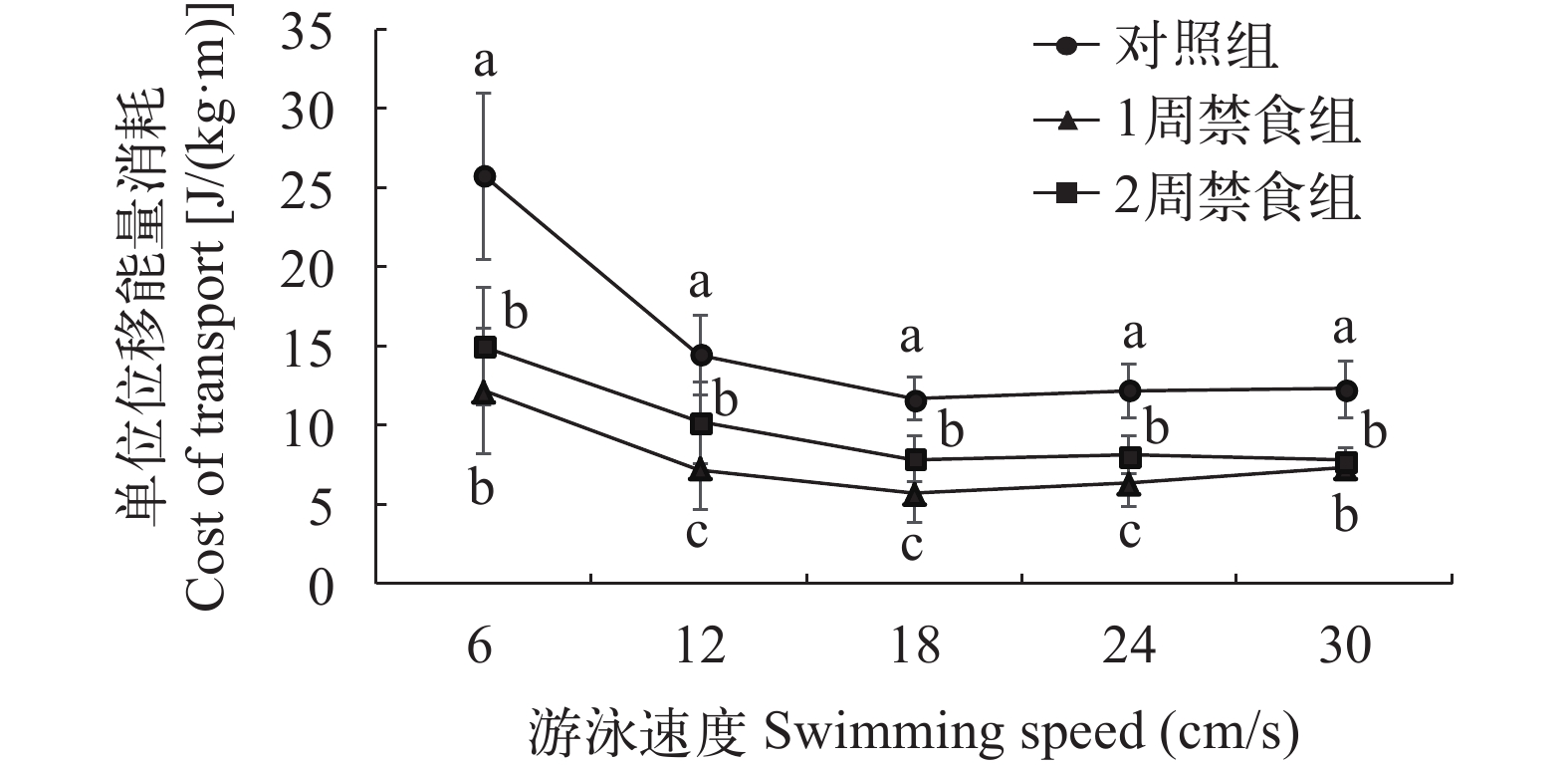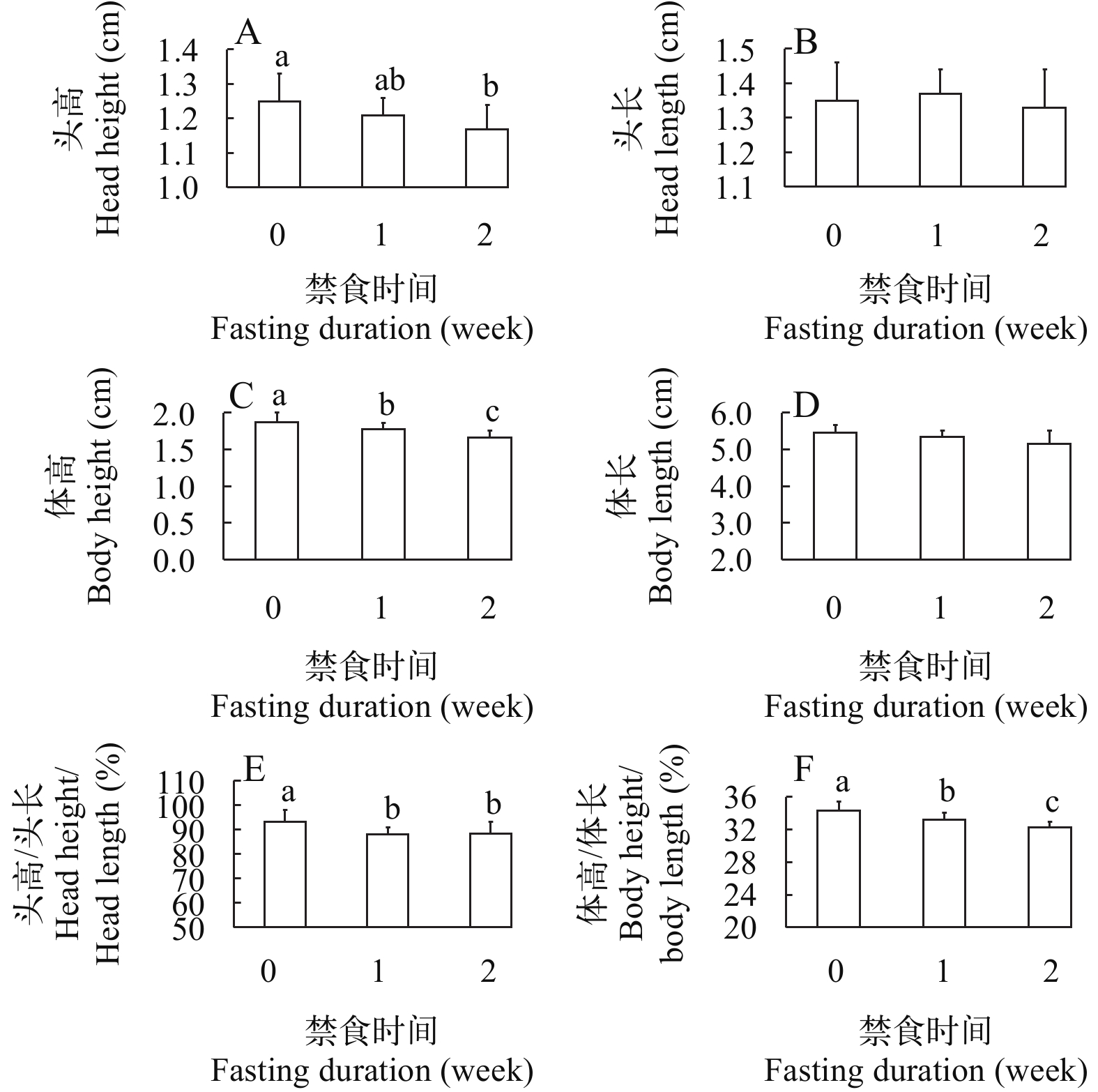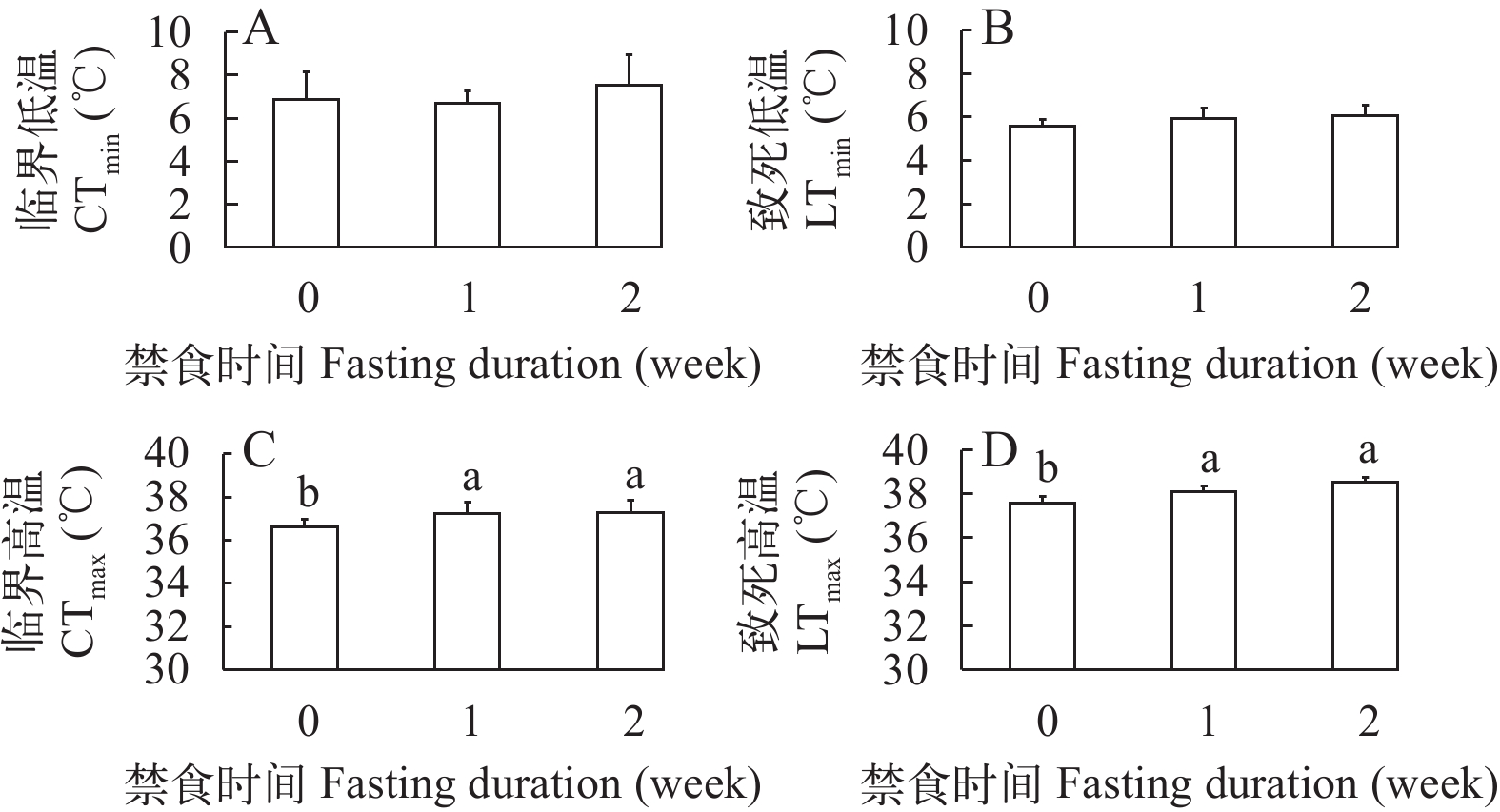FASTING ON SWIMMING PERFORMANCE, THERMAL TOLERANCE AND SPONTANEOUS ACTIVITY JUVENILE MYXOCYPRINUS ASIATICUS
-
摘要: 为了考察1—2周禁食对胭脂鱼(Myxocyprinus asiaticus)幼鱼游泳能力、热耐受能力和自发运动的影响, 以胭脂鱼幼鱼[体质量(3.26±0.64) g, 体长(5.32±0.32) cm]为实验对象, 将其随机分成对照组、1周禁食组和2周禁食组测定其有氧运动能力及其代谢、热耐受能力和自发运动行为相关参数。结果发现: 1周禁食组和2周禁食组的静止代谢和临界游泳速度与对照组没有显著性差异, 但其最大代谢率、代谢空间、单位位移能量消耗、头高/头长及体高/体长显著低于对照组(P<0.05); 1周禁食组和2周禁食组的临界低温和致死低温与对照组没有显著性差异, 但其临界高温和致死高温显著高于对照组(P<0.05); 1周禁食组和2周禁食组的运动总距离、平均运动速度和运动时间百分比与对照组没有显著性差异。综上所述: 胭脂鱼幼鱼采取有氧运动能力和自发运动行为的维持策略应对1—2周禁食胁迫, 这可能有利于维持其日常的觅食活动。此外, 尽管对低温耐受没有显著影响, 但1—2周的禁食显著提高了胭脂鱼幼鱼的高温耐受能力。Abstract: To investigate the effects of fasting for 1—2 weeks on swimming performance, thermal tolerance and spontaneous activity juvenile Chinese sucker (Myxocyprinus asiaticus), the body mass and body length of 108 fish with (3.26±0.64) g and (5.32±0.32) cm were randomly divided into 3 groups, i.e., control group, 1 week and 2 weeks fasting group. Then, relevant parameters of swimming ability, thermal tolerance and spontaneous activity of these fishes were measured after different fasting times. Fasting for 1—2 weeks has no effects on the rest metabolic rate and critical swimming speed of M. asiaticus. Maximum metabolic rate, metabolic scope, cost of transport, head height/head length and body height/body length significantly increased in 1 week and 2 weeks fasting groups compared to that in control group (P<0.05). Fasting for 1—2 weeks has no effects on the critical thermal minimum and lethal thermal minimum of M. asiaticus. Critical and lethal thermal maximum significantly increased in 1 week and 2 weeks fasting groups compared to that in control group (P<0.05). Fasting for 1—2 weeks has no effects on the total movement distance, average movement speed and percent time spent moving of M. asiaticus. Our results suggested that aerobic swimming capacity and spontaneous activity of M. asiaticus was not affected by fasting for 1—2 weeks, which may be beneficial for maintaining their daily foraging activities. Moreover, fasting for 1—2 weeks has no significant impact on the low-temperature tolerance, but this stress can improve the high-temperature tolerance of M. asiaticus.
-
Keywords:
- Fasting /
- Swimming performance /
- Thermal tolerance /
- Spontaneous activity /
- Myxocyprinus asiaticus
-
由于自然界中食物资源空间的分布差异、季节的循环更替以及环境的剧烈变化, 鱼类经常会面临食物短缺的胁迫[1]。鱼类在长期的进化过程中形成了各种形态、生理和行为的适应策略去应对饥饿胁迫[2, 3]。鱼类的游泳能力根据对氧气的需求可以分为有氧和无氧两种类型, 有氧游泳能力与鱼类的洄游和觅食等活动密切相关, 通常采用测定其临界游泳速度(Critical swimming speed, Ucrit)来评估[4, 5]。无氧游泳能力与鱼类的避敌和穿越激流等活动密切相关, 通常采用测定其匀加速最大游泳速度(Constant acceleration speed, Ucat)来评估[6]。鱼类的热耐受能力能够反映其在特定温度环境中的生存能力, 其常用评价指标包括临界高温(The critical thermal maximum, CTmax)、临界低温(Critical thermal minimum, CTmin)、致死高温(Lethal thermal maximum, LTmax)和致死低温(Lethal thermal minimum, LTmin)[7, 8]。自发运动是鱼类内在生理状态和行为特征的直观表现, 与其觅食和保卫领地等活动密切相关, 通常采用运动总距离(Total movement distance, TMD)、平均运动速度(Average movement speed, AMS)和运动时间百分比(Percent time spent moving, PTM)等指标来评估[9, 10]。大量的研究发现, 长期的食物资源短缺会对鱼类的生理功能产生负面影响, 并且改变其行为模式[6, 11, 12]。但短期(1—2周)禁食对鱼类生理和行为的影响并未得到一致的结论, 这可能与其生活习性有关[13, 14]。
胭脂鱼(Myxocyprinus asiaticus)属鲤形目(Cypriniformes), 亚口鱼科(Catostomidae), 胭脂鱼属(Myxocyprinus), 是我国长江流域特有的温水性鱼类[15]。由于人为过度捕捞等原因, 其野生种群数量稀少, 亟待保护[16]。有关胭脂鱼幼鱼的有氧运动能力(Ucrit)及其影响因素已有研究报道[17-20]。我们先前的研究发现, 1—2周禁食对胭脂鱼无氧运动能力(Ucat)和集群行为都没有显著影响[14]。本研究旨在进一步探究胭脂鱼有氧运动能力(Ucrit)及其代谢、热耐受(CTmax、CTmin、LTmax、LTmin)和自发运动行为(TMD、AMS、PTM)对1—2周禁食的响应, 丰富其生理生态学资料。
1. 材料与方法
1.1 实验材料和禁食处理
实验用胭脂鱼幼鱼于2022年1月购买于重庆市永川区水产养殖场。所有实验对象均来源于一对亲本繁殖的同一批后代。将胭脂鱼幼鱼置于循环水养殖系统中驯养14d, 水温和溶氧分别维持在(25±0.5)℃和8 mg/L左右, 每天用充分曝气的水更换养殖水体10%, 光周期制度为12L﹕12D。用红线虫商品饵料每日饱足投喂2次(09: 00和18: 00), 投喂1h后收集粪便和残饵。
在驯养期结束后, 挑选健康且大小基本一致的实验幼鱼[(3.26±0.64) g, (5.32±0.32) cm]随机分为3组: 对照组、1周禁食组和2周禁食组。所有实验鱼放置于同一套循环水养殖系统中用拦网分隔的3个养殖单元(500 mm×800 mm), 每个养殖单元放养实验鱼36尾。禁食处理期间除了没有饵料投喂以外, 其他实验条件与驯养期相同。
1.2 实验方法
静止代谢率、游泳能力和体型参数测定 将实验鱼放置在“循环密闭式代谢测定仪”中测量其静止代谢率(Resting metabolic rate, RMR), 每个处理组样本数为8尾, 各组间实验鱼体质量和体长都无显著性差异(表 1)。操作步骤为: 将单尾实验鱼放入仪器呼吸室中适应12h, 随后使用溶氧仪(HQ30d, 美国哈希公司)测定实验鱼45个代谢率, 取其平均值作为RMR。代谢率测定分3轮, 每轮间隔3h并连续测定15min, 10s记录1次溶氧值, 1min计算1个代谢率。将实验鱼取出后记录15min内空白管(细菌耗氧)的溶氧值。实验鱼代谢率[mg O2/(kg·h)]的计算公式如下[21]:
表 1 实验鱼的体质量和体长(平均值±标准差)Table 1. Body mass and body length of the experimental fish in the present study (mean±SD)参数 Parameter 对照组Controlgroup 1 周禁食组1 week fasting group 2周禁食组2 weeks fasting group 临界游泳速度和体型Critical swimming speed and body shape 体质量Body mass (g) N=8 3.24±0.64 3.25±0.67 3.21±0.62 体长Body length (cm) N=8 5.30±0.20 5.22±0.31 5.15±0.36 高温耐受 Thermal maximum 体质量Body mass (g) N=8 3.39±0.71 3.25±0.40 3.18±0.47 体长Body length (cm) N=8 5.39±0.24 5.24±0.21 5.10±0.31 低温耐受Thermal minimum 体质量Body mass (g) N=8 3.25±0.69 3.39±0.44 3.11±0.53 体长Body length (cm) N=8 5.29±0.30 5.34±0.18 5.13±0.34 自发运动Spontaneous activity 体质量Body mass (g) N=10 3.31±0.54 3.15±0.52 3.20±0.53 体长Body length (cm) N=10 5.37±0.32 5.12±0.30 5.22±0.35 $ V{\rm{O}}_{2} = (M_{t} − M_{0}) × 0.15 × 60/(G × 1000)$


(1) 式中, VO2代表实验鱼代谢率, Mt为1min期间溶氧值随时间变化的斜率, M0为细菌耗氧的溶氧值变化斜率, 0.15为代谢仪体积(L), 60为60min。G表示实验鱼的体质量(g)。
采用“鱼类游泳代谢测定仪”测定实验鱼的Ucrit[5]。测定方法简述如下: 实验鱼RMR测定结束后将其放仪器中适应6h(水流速度为6 cm/s)。随后以每20min增加6 cm/s的流速直至实验鱼达到力竭状态, 力竭判断标准为实验鱼失去前进游泳能力, 并停留在游泳代谢仪的尾部20s以上。Ucrit的计算公式如下[5]:
$ U_{{\rm{crit}}} = V+(t/T)∆ V $


(2) This page contains the following errors:
error on line 1 at column 1: Start tag expected, '<' not foundBelow is a rendering of the page up to the first error.
$ V{\rm{O}}_{2} = 60 × {\rm{Slope}} × 3.5/(G × 1000)$


(3) 式中, Slope表示每档流速下实验鱼消耗溶氧的速率[mg O2/(L·min)], 即斜率。60表示60min, 3.5表示代谢仪呼吸室的总体积(L), G表示实验鱼的体质量(g)。在测定Ucrit过程中, 所测到的最大值定义为最大代谢率[Maximum metabolic rate, MMR, mg O2/(kg·h)], MMR与RMR的差值定义为代谢空间[Metabolic scope, MS, mg O2/(kg·h)]。COT(Cost of transport, 单位位移能量消耗)的计算依据以下公式[23]:
$ {\rm{COT}} = M{\rm{O}}_{ 2} × {\rm{OE}}/v $


(4) 式中, MO2[mg O2/(kg·h)]为实验鱼在给定的水流速度下的耗氧率, OE是氧热当量系数13.54 J/mg O2), v(m/h)是由cm/s转换的相对水流速度。
在Ucrit测定结束后, 将实验鱼取出采用MS-222(3-氨基苯甲酸乙酯甲基磺酸盐, 50 mg/L)轻度麻醉, 测量其体质量(g)、头高(cm)、头长(cm)、体高(cm)和体长(cm), 计算其头高/头长和体高/体长比值。
热耐受能力测定 从各个处理组中挑选16尾实验鱼进行热耐受测试(高温耐受和低温耐受各8尾), 各组间实验鱼体质量和体长都无显著性差异(表 1)。将实验鱼放置于装有充分曝气水体的容器(50 L)中适应1h, 单尾实验鱼放置在容器中单独的网格内(5 cm×8 cm)进行适应和测试, 水体温度25℃, 溶氧含量90%饱和以上。在适应期结束后, 采用加热器和电压调节器或冷水机对实验水体以0.3℃/min的速度升温或降温, 控制稳定的温度变化速率, 用数字温度计监控温度变化情况。当鱼第1次失去平衡时的温度记为临界高温(CTmax)或临界低温(CTmin), 当鱼失去平衡且鳃盖无反应时的温度记为致死高温(LTmax)或致死低温(LTmin)[7]。
自发运动的测试 为了考察1—2周禁食对实验鱼自发活动的影响, 在禁食实验结束24h后, 将单尾实验鱼放置于直径30 cm的圆柱形实验容器中适应1h, 水深5 cm, 水温(25±0.5)℃。用不透光的布将实验装置四面封闭, 内置LED灯管照明。适应期结束后, 用Logitech摄像头连续记录20min实验鱼的自发运动行为。运用Ethovision软件分析实验鱼的运动总距离(TMD)、平均运动速度(AMS)和运动时间百分比(PTM)[3]。每个处理组样本量都为10尾, 各组间实验鱼体质量和体长都无显著性差异(表 1)。
统计分析 运用Excel 2003和SPSS 17.0对所有实验数据进行统计和分析。实验数据进行正态性(Shapiro-Wilks 检验) 和方差齐性检验, 如果通过检验则采用单因素方差分析(ANOVA), 若差异显著则进行多重比较(LSD法)。临界游泳速度、自发运动参数和体型参数采用体长作为协变量进行分析, 代谢率相关参数和热耐受参数采用体质量作为协变量进行分析。以平均值±标准差(mean±SD)表示数据结果, 统计显著性水平定为 P<0.05。
2. 结果
2.1 临界游泳速度及其代谢率
1周禁食组和2周禁食组的Ucrit和RMR与对照组都无显著差异(图 1和表 2)。1周禁食组和2周禁食组的MMR和MS显著小于对照组(P<0.001)。
表 2 禁食对胭脂鱼游泳能力、热耐受和自发运动参数的单因素协方差统计分析表Table 2. Effects of fasting on several variables related to swimming performance, thermal tolerance and spontaneous activity in juvenile Chinese sucker based on the results of One-way analysis of variance指标Index 协变量Covariate effect 禁食Fasting effect 临界游泳速度Critical swimming speed (bl/s) F1,23=0.859, F2,23=0.421, P=0.367 P=0.663 静止代谢率Resting metabolic rate [mg O2/(kg·h)] F1,23=0.002, F2,23=1.088, P=0.966 P=0.359 最大代谢率Maximum metabolic rate [mg O2/(kg·h)] F1,23=0.571, F2,23=25.796, P=0.460 P<0.001 代谢空间Metabolic scope [mg O2/(kg·h)] F1,23=0.554, F2,23=19.250, P=0.467 P<0.001 头高/头长Head height/Head length F1,23=0.366, F2,23=3.761, P=0.552 P=0.041 体高/体长Body height/Body length F1,23=0.412, F2,23=7.278, P=0.528 P=0.004 临界高温Critical thermal maximum (℃) F1,23=2.203, F2,23=5.974, P=0.153 P=0.009 致死高温Lethal thermal maximum (℃) F1,23=2.945, F2,23=29.972, P=0.102 P<0.001 临界低温Critical thermal minimum (℃) F1,23=1.658, F2,23=0.885, P=0.213 P=0.428 致死低温Lethal thermal minimum (℃) F1,23=2.157, F2,23=3.285, P=0.157 P=0.058 运动总距离Total movement distance (cm) F1,29=0.050, F2,29=1.156, P=0.825 P=0.330 平均运动速度Average movement speed (cm/s) F1,29=0.660, F2,29=0.325, P=0.424 P=0.725 运动时间百分比Percent time spent moving (%) F1,29=0.409, F2,29=0.815, P=0.528 P=0.454 在相同的游泳速度下, 1周禁食组和2周禁食组的耗氧率以及单位位移能量消耗都显著低于对照组(P<0.001; 图 2、图 3和表 3)。
表 3 禁食和游泳速度对胭脂鱼耗氧率和单位位移能量消耗的双因素协方差统计分析表Table 3. Effects of fasting and swimming speed on oxygen consumption (MO2) and cost of transport (COT) in juvenile Chinese sucker based on the results of Two-way analysis of variance指标Index 协变量Covariate effect 禁食Fasting effect 游泳速度Swimming speed effect 交互作用Interaction effect 耗氧率Oxygen consumption[mg O2/(kg·h)] F1,105=9.680, P=0.003 F2,105=76.975, P<0.001 F4,105=97.804, P<0.001 F8,105=2.568, P=0.015 单位位移能量消耗Cost of transport[J/(kg·m)] F1,105=5.672, P=5.020 F2,105=48.910, P<0.001 F4,105=48.631, P<0.001 F8,105=4.041, P<0.001 2.2 体型参数
2周禁食组头高、体高和体长都显著低于对照组, 头长在各组间没有显著差异(图 4A—D)。1周禁食组和2周禁食组的头高/头长没有显著差异, 但都显著小于对照组(P=0.041; 表 2和图 4E)。1周禁食组的体高/体长显著低于对照组, 但显著高于2周禁食组(P=0.004; 表 2和图 4F)。
2.3 热耐受能力
1周禁食组和2周禁食组的临界低温和致死低温与对照组差异不显著(表 2、图 5A和图 5B), 但临界高温(P=0.009)和致死高温(P<0.001)显著高于对照组(表 2、图 5C和图 5D)。
2.4 自发运动
1周禁食组和2周禁食组的运动总距离、平均运动速度及运动时间百分比与对照组差都无显著性差异(表 2和图 6)。
3. 讨论
3.1 禁食对胭脂鱼幼鱼静止代谢和游泳能力的影响
在面临食物缺乏时, 鱼类会通过降低基础代谢水平, 减少自身能量消耗, 以维持更长的生存时间。比如, 禁食2周的南方鲇(Silurus meridionalis)、鲇(Silurus asotus)和鲤(Cyprinus carpio)的静止代谢分别下降41%、26%和20%[11, 24, 25]。但本研究发现, 胭脂鱼幼鱼的静止代谢在2周的禁食后并没有显著变化, 这与鲫(Carassius auratus)的研究结果相似[26]。这种自身基础代谢水平的维持策略虽然不适用于长期的饥饿胁迫, 但可能有利于在1—2周食物缺乏期间维持其觅食和避敌等基本生理功能[1]。
胭脂鱼作为一种珍稀鱼类, 其有氧运动能力受到了广泛的关注, 但以往研究报道的胭脂鱼Ucrit数据并不一致。有研究发现, 在18.9— 24.3℃, 野生胭脂鱼(体长16.5 cm)Ucrit 约为4.5 bl/s[19]。在22℃条件下, 3种规格养殖胭脂鱼幼鱼(体长分别为3.04、4.08和6.51 cm)Ucrit分别为11.14、9.05和7.45 bl/s[17]。也有研究发现, 在25℃条件下, 养殖胭脂鱼幼鱼(体长4.59 cm)的Ucrit约为7.46 bl/s[20]。本研究发现, 胭脂鱼幼鱼(体长约5.22 cm)Ucrit约为5.39 bl/s, 这与付翔等[18]的研究结果相似。不同研究所获得的胭脂鱼Ucrit数据的差异可能与测定仪器、测定环境条件、测定前驯养条件、实验对象来源及规格等因素有关。
以往的研究发现, 许多鱼类的有氧游泳能力在食物缺乏环境下通常表现出显著下降趋势。比如, 2周的禁食导致鲤科鱼类鲫(Carassius auratus)和草鱼(Ctenopharynodon idellus)的Ucrit 分别显著下降24%和19%[27, 28]。鲇科鱼类南方鲇和鲟科鱼类小体鲟(Acipenser ruthenus)的 Ucrit 在禁食2周后也分别显著下降26.0%和16%[29, 30]。研究者认为这可能与其在禁食期间的氧气摄取能力(MMR)的降低, 可利用代谢空间(MS)的缩小及游泳效率(单位位移能量消耗)的下降等因素有关。本研究发现, 2周的禁食并没有对胭脂鱼幼鱼的Ucrit产生显著的影响。值得注意的是, 1—2周禁食虽然导致胭脂鱼幼鱼的MMR和MS的显著降低。但是其单位位移能量消耗却在1—2周禁食期间显著降低, 暗示其游泳效率显著提高, 这可能与其体型变得更加低矮(头高/头长以及体高/体长减小), 游泳阻力减小有关[31]。由此表明, 在1—2周禁食胁迫下胭脂鱼幼鱼有氧游泳能力的维持可能是由于其游泳效率的显著提高抵消了氧气摄取能力的下降及可利用代谢空间的减少的负面影响。
3.2 禁食对胭脂鱼幼鱼热耐受能力的影响
鱼类的热耐受能力受到各种环境因素的显著影响, 一直受到研究者的广泛关注[32—34]。研究发现, 当食物供给不足时(0.25%体质量/d), 中吻鲟(Acipenser medirostris)幼鱼可能通过自身生理功能的调节在一定程度上提高其高温耐受能力[32]。2周的饥饿导致中华倒刺鲃(Spinibarbus sinensis)的高温耐受能力显著地降低, 研究者认为这可能与饥饿导致鱼类呼吸和循环系统功能的减弱等因素有关[11, 33]。本研究发现, 尽管2周的禁食导致胭脂鱼幼鱼的MMR和MS的显著降低, 但是其CTmax和LTmax反而表现出显著提高。由此表明, 1—2周禁食导致胭脂鱼幼鱼高温耐受能力的显著提高可能与其呼吸能力的降低和代谢空间的缩减并无直接关联, 其内在机制还有待进一步探究。
3.3 禁食对胭脂鱼幼鱼自发运动的影响
在面临食物缺乏的环境胁迫下, 鱼类自发运动不仅受到禁食时间长短的影响, 还具有明显的种间差异[3, 25, 35]。迄今为止, 短期(1—2周)禁食对鱼类自发运动的影响并未得出一致的结论。研究发现, 一些鱼类在面临1—2周饥饿胁迫时通常表现出自发运动的提高, 这将有利于增加获得食物的机会, 比如牙鲆(Paralichthys olivaceus)、三刺鱼(Gasterosteus aculeatus)、鲤和鲢(Hypophthalmichthys molitrix)[3, 25, 36, 37]。但也有鱼类在禁食后表现出自发运动的显著降低, 比如南方鲇在2周的禁食后其TMD和PTM分别下降了88%和87%, 研究者认为这可能与其伏击捕食的习性相关[3]。本研究发现, 2周的禁食并没有对胭脂鱼幼鱼的TMD、AMS和PTM产生显著影响。由此表明, 胭脂鱼幼鱼在面临1—2周禁食胁迫时采取自发运动的维持策略, 这与青鱼(Mylopharyngodon piceus)和草鱼 (Ctenopharyngodon idellus)的研究结果相似[3]。由于胭脂鱼的主要食物为水生昆虫幼虫、藻类和植物碎屑等, 其觅食过程需要较长时间的活动。因此, 结合胭脂鱼幼鱼的基础代谢耗能和有氧运动能力在1—2周禁食期间没有显著变化的结果, 我们认为其自发运动的维持可能有利于胭脂鱼幼鱼在食物短缺期间执行日常食物的搜索活动。
-
表 1 实验鱼的体质量和体长(平均值±标准差)
Table 1 Body mass and body length of the experimental fish in the present study (mean±SD)
参数 Parameter 对照组Controlgroup 1 周禁食组1 week fasting group 2周禁食组2 weeks fasting group 临界游泳速度和体型Critical swimming speed and body shape 体质量Body mass (g) N=8 3.24±0.64 3.25±0.67 3.21±0.62 体长Body length (cm) N=8 5.30±0.20 5.22±0.31 5.15±0.36 高温耐受 Thermal maximum 体质量Body mass (g) N=8 3.39±0.71 3.25±0.40 3.18±0.47 体长Body length (cm) N=8 5.39±0.24 5.24±0.21 5.10±0.31 低温耐受Thermal minimum 体质量Body mass (g) N=8 3.25±0.69 3.39±0.44 3.11±0.53 体长Body length (cm) N=8 5.29±0.30 5.34±0.18 5.13±0.34 自发运动Spontaneous activity 体质量Body mass (g) N=10 3.31±0.54 3.15±0.52 3.20±0.53 体长Body length (cm) N=10 5.37±0.32 5.12±0.30 5.22±0.35 表 2 禁食对胭脂鱼游泳能力、热耐受和自发运动参数的单因素协方差统计分析表
Table 2 Effects of fasting on several variables related to swimming performance, thermal tolerance and spontaneous activity in juvenile Chinese sucker based on the results of One-way analysis of variance
指标Index 协变量Covariate effect 禁食Fasting effect 临界游泳速度Critical swimming speed (bl/s) F1,23=0.859, F2,23=0.421, P=0.367 P=0.663 静止代谢率Resting metabolic rate [mg O2/(kg·h)] F1,23=0.002, F2,23=1.088, P=0.966 P=0.359 最大代谢率Maximum metabolic rate [mg O2/(kg·h)] F1,23=0.571, F2,23=25.796, P=0.460 P<0.001 代谢空间Metabolic scope [mg O2/(kg·h)] F1,23=0.554, F2,23=19.250, P=0.467 P<0.001 头高/头长Head height/Head length F1,23=0.366, F2,23=3.761, P=0.552 P=0.041 体高/体长Body height/Body length F1,23=0.412, F2,23=7.278, P=0.528 P=0.004 临界高温Critical thermal maximum (℃) F1,23=2.203, F2,23=5.974, P=0.153 P=0.009 致死高温Lethal thermal maximum (℃) F1,23=2.945, F2,23=29.972, P=0.102 P<0.001 临界低温Critical thermal minimum (℃) F1,23=1.658, F2,23=0.885, P=0.213 P=0.428 致死低温Lethal thermal minimum (℃) F1,23=2.157, F2,23=3.285, P=0.157 P=0.058 运动总距离Total movement distance (cm) F1,29=0.050, F2,29=1.156, P=0.825 P=0.330 平均运动速度Average movement speed (cm/s) F1,29=0.660, F2,29=0.325, P=0.424 P=0.725 运动时间百分比Percent time spent moving (%) F1,29=0.409, F2,29=0.815, P=0.528 P=0.454 表 3 禁食和游泳速度对胭脂鱼耗氧率和单位位移能量消耗的双因素协方差统计分析表
Table 3 Effects of fasting and swimming speed on oxygen consumption (MO2) and cost of transport (COT) in juvenile Chinese sucker based on the results of Two-way analysis of variance
指标Index 协变量Covariate effect 禁食Fasting effect 游泳速度Swimming speed effect 交互作用Interaction effect 耗氧率Oxygen consumption[mg O2/(kg·h)] F1,105=9.680, P=0.003 F2,105=76.975, P<0.001 F4,105=97.804, P<0.001 F8,105=2.568, P=0.015 单位位移能量消耗Cost of transport[J/(kg·m)] F1,105=5.672, P=5.020 F2,105=48.910, P<0.001 F4,105=48.631, P<0.001 F8,105=4.041, P<0.001 -
[1] Mehner T, Wieser W. Energetics and metabolic correlates of starvation in juvenile perch (Perca fluviatilis) [J]. Journal of Fish Biology, 1994, 45(2): 325-333. doi: 10.1111/j.1095-8649.1994.tb01311.x
[2] 李秀明, 付世建, 张耀光. 饥饿对鲤幼鱼内脏器官指数和力竭运动后代谢特征的影响 [J]. 水生生物学报, 2021, 45(2): 259-266. doi: 10.7541/2021.2019.167 Li X M, Fu S J, Zhang Y G. Effects of starvation on index of visceral organs and excess post-exercise oxygen consumption of juvenile common carp (Cyprinus carpio) [J]. Acta Hydrobiologica Sinica, 2021, 45(2): 259-266. doi: 10.7541/2021.2019.167
[3] Li X M, Zhang Y G, Fu S J. Effects of short-term fasting on spontaneous activity and excess post-exercise oxygen consumption in four juvenile fish species with different foraging strategies [J]. Biology Open, 2020, 9(9): bio051755. doi: 10.1242/bio.051755
[4] Zhou L Y, Fu S J, Fu C, et al. Effects of acclimation temperature on the thermal tolerance, hypoxia tolerance and swimming performance of two endangered fish species in China [J]. Journal of Comparative Physiology B, 2019, 189(2): 237-247. doi: 10.1007/s00360-018-01201-9
[5] Li X M, Pang X, Zheng H, et al. Effects of prolonged exercise training and exhaustive chasing training on the swimming performance of an endangered bream Megalobrama pellegrini [J]. Aquatic Biology, 2017(26): 125-135.
[6] 庞旭, 付世建, 曹振东, 等. 饥饿和温度驯化对中华倒刺鲃静止代谢和游泳能力的影响 [J]. 生态学报, 2016, 36(7): 1854-1860. Pang X, Fu S J, Cao Z D, et al. The effects of fasting and acclimation temperature on the resting metabolism and swimming performance in qingbo (Spinibarbus sinensis) [J]. Acta Ecologica Sinica, 2016, 36(7): 1854-1860.
[7] 付康康, 曹振东, 付世建. 温度驯化对高体鳑鲏热耐受及低氧耐受能力的影响 [J]. 生态学杂志, 2015, 34(6): 1586-1590. Fu K K, Cao Z D, Fu S J. Effect of acclimation temperature on thermal tolerance and hypoxia tolerance in Rhodeus ocellatus [J]. Chinese Journal of Ecology, 2015, 34(6): 1586-1590.
[8] Underwood Z E, Myrick C A, Rogers K B. Effect of acclimation temperature on the upper thermal tolerance of Colorado River cutthroat trout Oncorhynchus clarkii pleuriticus: thermal limits of a North American salmonid [J]. Journal of Fish Biology, 2012, 80(7): 2420-2433. doi: 10.1111/j.1095-8649.2012.03287.x
[9] Fu S J, Zeng L Q, Li X M, et al. The behavioural, digestive and metabolic characteristics of fishes with different foraging strategies [J]. The Journal of Experimental Biology, 2009, 212(14): 2296-2302. doi: 10.1242/jeb.027102
[10] Xia J G, Cao Z D, Peng J L, et al. The use of spontaneous behavior, swimming performances and metabolic rate to evaluate toxicity of PFOS on topmouth gudgeon Pseudorasbora parva [J]. Acta Ecologica Sinica, 2014, 34(5): 284-289. doi: 10.1016/j.chnaes.2014.07.006
[11] Fu S J, Pang X, Cao Z D, et al. The effects of fasting on the metabolic interaction between digestion and locomotion in juvenile southern catfish (Silurus meridionalis) [J]. Comparative Biochemistry and Physiology Part A:Molecular & Integrative Physiology, 2011, 158(4): 498-505.
[12] 覃英莲, 彭韩柳依, 付世建. 饥饿对捕食者鱼和猎物鱼快速启动游泳能力及捕食-逃逸行为的影响 [J]. 生态学杂志, 2016, 35(9): 2429-2434. Qin Y L, Peng H, Fu S J. Effects of food deprivation on fast-start swimming and predator-prey interaction between a predator and prey fish species [J]. Chinese Journal of Ecology, 2016, 35(9): 2429-2434.
[13] 李秀明, 侯起淼, 张耀光. 短期饥饿对大口黑鲈幼鱼自发运动和力竭运动后代谢的影响 [J]. 重庆师范大学学报(自然科学版), 2022, 39(3): 1-7. Li X M, Hou Q M, Zhang Y G. Effect of short-term starvation on spontaneous activity and excess post-exercise oxygen consumption of juvenile Micropterus salmoides [J]. Journal of Chongqing Normal University (Natural Science), 2022, 39(3): 1-7.
[14] 周龙艳. 长江流域几种珍稀鱼类对环境因子胁迫的生理与行为响应研究 [D]. 重庆: 重庆师范大学, 2020: 55-57. Zhou L Y. Physiological and behavioral responses to environmental stress of several endangered fish species in the Yangtze River [D]. Chongqing: Chongqing Normal University, 2020: 55-57.
[15] Gao Z X, Li Y, Wang W M. Threatened fishes of the world: Myxocyprinus asiaticus Bleeker 1864 (Catostomidae) [J]. Environmental Biology of Fishes, 2008, 83(3): 345-346. doi: 10.1007/s10641-008-9347-5
[16] 刘晓霞, 周天舒, 唐文乔. 长江近口段沿岸4种珍稀、重要鱼类的资源动态 [J]. 长江流域资源与环境, 2016, 25(4): 552-559. Liu X X, Zhou T S, Tang W Q. Resource dynamic of 4 species of rare important fish in coastal region of the Jingjiang section of the Yangtze River [J]. Resources and Environment in the Yangtze Basin, 2016, 25(4): 552-559.
[17] 石小涛, 陈求稳, 刘德富, 等. 胭脂鱼幼鱼的临界游泳速度 [J]. 水生生物学报, 2012, 36(1): 133-136. Shi X T, Chen Q W, Liu D F, et al. Critical swimming speed of young Chinese sucker (Myxocryprinus asiaticus) [J]. Acta Hydrobiologica Sinica, 2012, 36(1): 133-136.
[18] 付翔, 付成, 付世建. 五种淡水鱼类幼鱼游泳能力的比较 [J]. 生态学杂志, 2020, 39(5): 1629-1635. Fu X, Fu C, Fu S J. Comparison of swimming ability among five freshwater fish species [J]. Chinese Journal of Ecology, 2020, 39(5): 1629-1635.
[19] 丁少波, 施家月, 黄滨, 等. 大渡河下游典型鱼类的游泳能力测试 [J]. 水生态学杂志, 2020, 41(1): 46-52. Ding S B, Shi J Y, Huang B, et al. Swimming capability of six typical fish species from the lower Dadu River [J]. Journal of Hydroecology, 2020, 41(1): 46-52.
[20] 周龙艳, 付世建, 付成, 等. 背鳍缺失对胭脂鱼幼鱼游泳能力与反捕食能力的影响 [J]. 淡水渔业, 2019, 49(3): 47-51. doi: 10.3969/j.issn.1000-6907.2019.03.008 Zhou L Y, Fu S J, Fu C, et al. Effects of the dorsal fin loss on swimming ability and anti-predatory ability of juvenile Myxocyprinus asiaticus [J]. Freshwater Fisheries, 2019, 49(3): 47-51. doi: 10.3969/j.issn.1000-6907.2019.03.008
[21] Fu C, Fu S J, Wu Q Y, et al. Predation threat modifies relationships between metabolism and behavioural traits but not their ecological relevance in Chinese bream [J]. Marine and Freshwater Behaviour and Physiology, 2017, 50(5/6): 329-344.
[22] Pang X, Cao Z D, Peng J L, et al. The effects of feeding on the swimming performance and metabolic response of juvenile southern catfish, Silurus meridionalis, acclimated at different temperatures [J]. Comparative Biochemistry and Physiology Part A:Molecular & Integrative Physiology, 2010, 155(2): 253-258.
[23] Claireaux G, Couturier C, Groison A L. Effect of temperature on maximum swimming speed and cost of transport in juvenile European sea bass (Dicentrarchus labrax) [J]. The Journal of Experimental Biology, 2006, 209(17): 3420-3428.
[24] 汤洪芬, 曹振东, 付世建. 饥饿对鲇鱼幼鱼静止代谢率的影响 [J]. 重庆师范大学学报(自然科学版), 2007, 24(1): 72-75. Tang H F, Cao Z D, Fu S J. The influence of starvation on metabolism of the juvenile Chinese catfish (Silurus astotus Linnaeus) [J]. Journal of Chongqing Normal University (Natural Science Edition), 2007, 24(1): 72-75.
[25] 付成, 曹振东, 付世建. 温度和饥饿对鲤鱼幼鱼静止代谢率及自发运动的影响 [J]. 动物学杂志, 2012, 47(2): 85-90. Fu C, Cao Z D, Fu S J. The influence of temperature and starvation on resting metabolic rate and spontaneous activity in juvenile Cyprinus carpio [J]. Chinese Journal of Zoology, 2012, 47(2): 85-90.
[26] 凌鸿, 曾令清. 饥饿对鲫幼鱼静止代谢及个性行为的影响 [J]. 重庆师范大学学报(自然科学版), 2019, 36(5): 52-59. Ling H, Zeng L Q. Effects of starvation on resting metabolic rate and personality behavior of juvenile Carassius auratus [J]. Journal of Chongqing Normal University (Natural Science), 2019, 36(5): 52-59.
[27] 彭韩柳依, 曹振东, 付世建. 饥饿对鲫鱼幼鱼游泳能力的影响 [J]. 生态学杂志, 2014, 33(10): 2756-2760. Peng H, Cao Z D, Fu S J. Effect of starvation on swimming performance of juvenile crucian carp [J]. Chinese Journal of Ecology, 2014, 33(10): 2756-2760.
[28] Cai L, Fang M, Johnson D, et al. Interrelationships between feeding, food deprivation and swimming performance in juvenile grass carp [J]. Aquatic Biology, 2014, 20(1): 69-76. doi: 10.3354/ab00546
[29] 曾令清, 彭韩柳依, 王健伟, 等. 饥饿对南方鲇幼鱼游泳能力个体变异和重复性的影响 [J]. 水生生物学报, 2014, 38(5): 883-890. Zeng L Q, Peng H, Wang J W, et al. The effects of food deprivation on individual variation and repeatability in swimming performance of juvenile southern catfish (Silurus meridionalis Chen) [J]. Acta Hydrobiologica Sinica, 2014, 38(5): 883-890.
[30] Cai L, Johnson D, Fang M, et al. Effects of feeding, digestion and fasting on the respiration and swimming capability of juvenile sterlet sturgeon (Acipenser ruthenus, Linnaeus 1758) [J]. Fish Physiology and Biochemistry, 2017, 43(1): 279-286. doi: 10.1007/s10695-016-0285-4
[31] Boily P, Magnan P. Relationship between individual variation in morphological characters and swimming costs in brook charr (Salvelinus fontinalis) and yellow perch (Perca flavescens) [J]. Journal of Experimental Biology, 2002, 205(7): 1031-1036. doi: 10.1242/jeb.205.7.1031
[32] Verhille C E, Lee S, Todgham A E, et al. Effects of nutritional deprivation on juvenile green sturgeon growth and thermal tolerance [J]. Environmental Biology of Fishes, 2016, 99(1): 145-159. doi: 10.1007/s10641-015-0463-8
[33] Pörtner H O, Mark F C, Bock C. Oxygen limited thermal tolerance in fish? Answers obtained by nuclear magnetic resonance techniques [J]. Respiratory Physiology & Neurobiology, 2004, 141(3): 243-260.
[34] 夏继刚, 黄艳, 付世建, 等. 斑马鱼热耐受性对温度驯化的响应及其性别差异 [J]. 生态学杂志, 2019, 38(8): 2477-2481. doi: 10.13292/j.1000-4890.201908.034 Xia J G, Huang Y, Fu S J, et al. Gender differences in thermal tolerance of zebrafish in response to temperature acclimation [J]. Chinese Journal of Ecology, 2019, 38(8): 2477-2481. doi: 10.13292/j.1000-4890.201908.034
[35] Pulgar J, Bozinovic F, Ojeda F P. Behavioral thermoregulation in the intertidal fish Girella laevifrons (Kyphosidae): the effect of starvation [J]. Marine and Freshwater Behaviour and Physiology, 1999, 32(1): 27-38. doi: 10.1080/10236249909379035
[36] Miyazaki T, Masuda R, Furuta S, et al. Feeding behaviour of hatchery-reared juveniles of the Japanese flounder following a period of starvation [J]. Aquaculture, 2000, 190(1/2): 129-138.
[37] Giles N. Predation risk and reduced foraging activity in fish: experiments with parasitized and non-parasitized three-spined sticklebacks, Gasterosteus aculeatus L [J]. Journal of Fish Biology, 1987, 31(1): 37-44. doi: 10.1111/j.1095-8649.1987.tb05212.x
-
期刊类型引用(4)
1. 杨清,李武新,曾令清. 镜鲤的热耐受及其影响因素. 水生生物学报. 2025(02): 76-86 .  本站查看
本站查看
2. 李小红,付成,付世建. 焦虑对雌性成年斑马鱼热耐受和游泳能力的影响. 水生生物学报. 2024(09): 1566-1572 .  本站查看
本站查看
3. 谭雪婷,张永飞,黄可人,付世建. 禁食对锦鲫最大代谢与逆境耐受能力的影响. 重庆师范大学学报(自然科学版). 2024(06): 1-6 .  百度学术
百度学术
4. 林小菊,俞立雄,吴池杰,王敏,田辉伍,王珂,刘明典,段辛斌. 禁食对8种幼鱼游泳运动能力的影响. 中国水产科学. 2023(12): 1457-1467 .  百度学术
百度学术
其他类型引用(0)



 下载:
下载:
